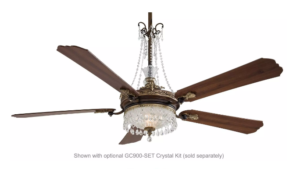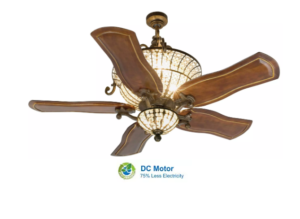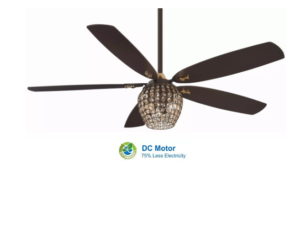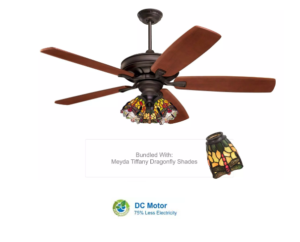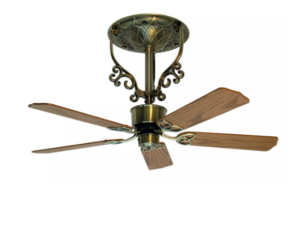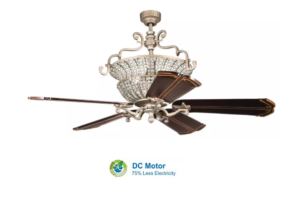If you are looking for the best crystal ceiling fan, you have come to the right place! We are domain experts in all things ceiling fans. We comprised this list after careful research. At the bottom, you will find our extensive buyer’s guide to crystal ceiling fans. In it, we cover everything you need to know to make an informed ceiling fan purchase. Enjoy!
The Savoy House Levantaria flaunts 8 light fixtures of white fabric shades containing one 13W energy-saving CFM bulb each. This chandelier fan is for indoor purposes only but it performs more than just a fan. It’s an air ionizing fan. It removes molds, smoke and fungi from the air. Thus, it circulates the best air possible to keep your environment healthy and refreshing.
The air-ionizing fan comes with 2394 CFM airflow capacity. The AC motor runs at 840 to 1186 RPM (revolutions per minute) at three different speeds. The AC motor energy efficiency is below average- 62 CFM/watt. So, you can’t expect it to save you more energy or blow your socks off.
The Savoy House offers the most grand and magnificent designs you can see in the market. The Levantaria series is not just an extravagant design but is very technologically advanced as well. On the top of it, the air- ionizing feature makes the model highly sought after by consumers nowadays.
The Minka Aire Cristafano fan features glistening pieces of SPECTRA Swarovski Crystal around its perimeter. It makes use of two 50 Watt Mini-Can Halogen bulbs to glow at its best. The fan with its exquisite Victorian style will be the highlight of your room décor. It’s primarily operated by a 3 speed wall control and has other optional controls.
The Cristafano features a built-in uplight that casts a gorgeous mood setting glow on the ceiling. The breeze rating of the fan is average with a wind speed factor of 2.84 MPH. However, the fan provides major airflow with 7885 CFM making it ideal for larger areas as well. This provides the ultimate cooling effect.
The Minka Aire has always been a customer favorite for creating modern and chic designs. This time too they have pushed the limits with the Cristafano series. It immediately grabs attention while impresses further with its unmatched performance.
The Craftmade Cortana Crystal is a fixed crystal fan with a 14 degree blade pitch for high airflow. The custom carved walnut blades are sold separately to ease customization. You can match your décor with optional light fixtures. This indoor fan comes in a contemporary and elegant Chandelier style to complement your existing room decor.
The 6-speed DC Motor saves up to 70% more energy than typical AC motors. It can switch from 50 RPM to 187 RPM (revolutions per minute) while delivering a decent amount of cooling breeze at 3.46 MPH. So, it can immediately cool down any small to medium sized room within minutes. As its efficiency rating is way above average (199 CFM/Watt vs an average of 86 CFM/Watt), this fan delivers strong cooling abilities at lower energy costs.
The Craftmade Company makes exquisite and timeless pieces to amplify your indoor aesthetics. The Cortana series is specially inspired by the colonial style of chandeliers. The fans are not just any piece of modern art but also represent themselves as ideal energy savers.
The Minka Aire Bling LED gives you a smooth performance even at its peak 135 RPM speed. With an average wind speed factor of 2.68 MPH, you can expect a moderate cooling breeze. However, the airflow is above average (5237 CFM vs an average of 5000 CFM) for even distribution of air throughout the room. That’s why it suits large rooms of your home.
As the DC motor is rated for operating at 50 watts per hour, the energy cost is low compared to conventional AC fans. Even if you run several fans at the same time, you will get more airflow per watts consumed owing to its 179 CFM/Watt efficiency rating. with better wind-chill effect, you can increase your thermostat temp to save up to 40% on your AC Bills as well.
The Minka Aire is known for its stylish and highly functional designs. This Bling LED model is not just another great addition to its catalog but also is a reasonably priced product to make its customers happy.
The Emerson Carrera Grande looks royal with its solid walnut wooden blades designed by the famous custom lighting designer Meyda Tiffany. It incorporates an efficient DC Motor that consumes less than 22 watts of electricity. As it is highly customizable, you get blades in various options of 54”, 60” and 72” finish.
It is primarily an indoor fan but is damp rated when used with B77, B78 or B79 series blades. With a six-speed wall control, you can also adjust its dimmable uplight and downlight bulbs. The remote operates from a 30-feet distance. For good overall cooling it has an airflow rating of 7929 CFM. Moreover, it saves up to 40% on your AC Bills.
Emerson is one of the most trustworthy brands in the fan market. All of its models are crafted with uniqueness. The Emerson Carrera Grande is one of them which is sure to get you compliments for its design and performance.
The Fanimation Americana Short is a regency style ceiling fan designed for indoors use only. The fan flaunts reversible oak/walnut finished blades that can be customized as per your tastes. The blades come in 44”, 52” or 59” sizes. The light fixtures are elegant and optional so you can change them as per your décor.
It comes with a 3 speed traditional pull chain control which aids its style further. The fan gives a moderate cooling breeze within its min and max speed of 25 RPM to 70 RPM. It is appropriate for rooms that don’t need much cooling. Essentialy, it’s equal parts fan, light, and art. The use of AC motor makes it reasonably priced but it won’t be as smooth and quiet running as a DC motor.
Fanimation is a go to choice for customers or unique and antique designs. The Americana Short models are perfect for high ceilings that will look elegant in either rustic or contemporary atmosphere.
The Craftmade Cortana Crystal Ceiling Fan comes with a 6-speed DC motor and a 187 RPM maximum speed. It gives you a decent cooling breeze at 5977 CFM airflow. The 199 CFM/watts efficiency is far above-average (86 CFM/Watts) to let you save more on your AC bills during the summer. On top of that, the DC motor draws only 30 watts per hour, making it a highly energy-efficient fan for heavy usage.
This Craftmade fan flaunts custom carved walnut blades (sold separately) to amplify your existing room decor. The light fixture is optional and features an uplight to give a shimmering elegance. You can control its intensity from a remote as well as a wall control. They have buttons for forward and reverse speed also.
Craftmade is your best-buy if you like customized fans to suit your decor. The Cortana Crystal in Athenian Obol is its another best addition to products under the range of $1,000. It could be your ideal bet for indoor applications.
As an affiliate partner, we may earn from qualifying purchases made on these products.
Everything To Know When Buying a Crystal Ceiling Fan.
We have a deep love for ceiling fans and live to help others understand these products as well as we do. That is why we took the time to write a ceiling fan buyers’ guide.
Buying a crystal ceiling fan for the first time can be overwhelming. There are many options for fans and each fan has different styles, sizes, functionality, blades, and installation steps. This is specifically true for crystal ceiling fans that come in a wide range of designs and patterns.
Fortunately for you, we have distilled all of the key variables down into an accessible and digestible guide. You can read this guide if you want an in-depth understanding of ceiling fans or you can skim it if you only want to better understand certain aspects of the fan itself.
This includes how to select a fan to buy, the types and angles of a fan’s blades, the pros and cons of the AC and DC motors that power fans, and how to install the fan on your ceiling. If you follow this guide you can be confident that you are making a well informed buying decision.
We know all things ceiling fans and want to pass on our learnings and insights to help you.
Most importantly, we know that once you evaluate, select, and install a ceiling fan it will likely remain in place for many years to come. That is because ceiling fans can be heavy, expensive, and labor intensive to install.
What is a crystal ceiling fan?
As the name implies, a ceiling fan made of crystal is one that provides air flow from your ceiling (like any other fan) but that is decorated with crystals. Nearly all crystal ceiling fans are made with real glass or plastic crystal substitutes to make the products more affordable.
A crystal or crystalline solid is a solid material whose constituents are arranged in a highly ordered microscopic structure, forming a crystal lattice that extends in all directions. Given the precision and complexity of crystals, you will want to ensure that the glass aligns with your aesthetic values.
All real crystals are made of glass. However, the glass used to craft chandelier crystals is very different from the glass in your windows, drinking cups, eyeglasses and so on. Crystal contains lead oxide, which gives it more weight and more refraction than normal glass. This is of particular note because it will make your ceiling fanny very shiny.
If you want shine, then a crystal ceiling fan is a great idea.
Are crystal ceiling fans like other types of fans? Yes!
A central air conditioning system consumes 3 kiloWatts, which is about 36 cents per hour. Running a fan only runs at 30 Watts, equivalent to only a cent per hour. The same is true for crystal fans.
This makes these fans affordable and energy efficient alternatives that many people love as they are good for you, your wallet, and the environment.
Running a crystal ceiling fan that turns off when a certain temperature range is reached is even more affordable.
Take the time to do research now before buying because the switching costs of changing your mind can be high.
Go through this evaluation check-list so that you better understand the types of motors, blades, installation units, and fans that exist. We encourage you to optimize for:
- Overall quality: in particular the speed of the motor to optimize for cooling efficacy and quietness.
- Aesthetics: in particular ensure that you are happy with how the fan looks, its color, shape, design, blade count, and the stacking of the glass crystals.
- Size: select the right size fan for the room you will be placing it in. Larger rooms require larger fans to create strong air flow.
Selecting the location of a crystal ceiling fan: Inside or Outside
Most crystal ceiling fans are used within the home. Very rarely are they used for outdoor structures. Before deciding which type of fan to buy, however, determine where you will place it.
Understanding the placement of a ceiling fan will help you select other attributes – like size, speed, and sound – that will enhance your experience with the fan.
Outdoor fans require different electrical strategies and water-proof finishes. Please keep this mind throughout the guide as we largely focus our attention and advice to those people who want to install indoor fans.
It is very unusual to place a crystal ceiling fan outside.
When placing the crystal ceiling fan in an indoor room, measure the size of the room.
Bathrooms tend to be smaller than bedrooms which tend to be smaller than living rooms or kitchens.
Knowing the approximate size of the room in which the fan will be placed is important.
Larger fans are best suited to larger rooms as their blades and motors move greater volumes of air.
Ceiling Fan Size Chart
| Room (in feet) | Cubic Feet/Minute | Fan Size |
| 6′ x 6′ | 3,000 – 4,500 | Shop: 24″ to 36″ |
| 10′ x 10′ | 4,000 – 5,500 | Shop: 37″ to 48″ |
| 12′ x 12′ | 6,200 – 7,500 | Shop: 49″ to 56″ |
| 15′ x 15′ | 7,000 – 9,000 | Shop: 60″ to 72″ |
| Larger | 9,000 – 11,000 | Shop: 80″ to 99″ |
The length of the blade of the fan and the size of the room go hand in hand.
In short, if you have a large room, buy a larger fan. The bigger the fan the better.
The common sizes for ceiling fans are 36, 44 and 52 inches, with the large fans having a blade wingspan of 60 inches.
Of course you can technically go even larger, with the largest recreational home fans having up to 99 inches of wingspan.
99 inches is 8.25 feet. That is a large fan indeed.
Measure the height of the ceiling and allow at least 7 feet and 6 inches of space.
It is wise and safe to place your fan at least 7 feet above your flooring.
Placing a ceiling fan high up protects tall individuals from hitting their head or having their hair caught while the fan is in motion. Fans need to be installed on ceilings and these installation bases take space as well.
An installation base is adjoined to a downrod, which is a simple piece of metal that the fan is connected to and hangs from.
The average American ceiling height today is 9 feet (2.7432 meters). This means that the average room can support a fan but with a shorter downrod.
If you have average sized ceilings you can afford to install no more than 1 foot and 6 inch downrods.
How to measure downrods and base mounts
A ceiling fan is composed of fan blades, a downrod, and an installation base.
The installation base attaches to the ceiling. The downrod connects to the base. And the fan itself hangs from the downrod.
Per the measurements mentioned above, the fan must be at least 7 feet and 6 inches above the ground if you have a standard 9 foot ceiling.
There is one exception: fans placed above beds, where you will not walk, require less height.
Many people enjoy selecting the fit and finish of the downrod as these pieces of metal or plastic come in different colors, shapes, and sizes and compliment the overall fan’s aesthetic.
As a general rule, more expensive crystal ceiling fans enable you to have longer and more customizable downrods. The downdrods tend to be longer – between 6 and 18 inches.
This is for functionality and aesthetics. Cheaper ceiling fans sometimes have very short – or almost nonexistent downrods – because the base and the fan are fused together.
Design and Look: What to Think About a crystal fan’s general aesthetics
A hugely important aspect of a ceiling fan is what it looks like. If you see the fan while lying in bed or while in your living room you will want it to look great.
The base and downrod are not nearly as important as the blades for how a fan looks in a room.
Blades come in different cuts, lengths, seizes, finishes, colors and of course quantities.
Crystal is shiny and bright. Your other interior decorations will need to match this aesthetic.
How many blades should a crystal ceiling fan have?
At a minimum, a ceiling fan will have two blades though four or five are certainly more common.
A two blade fan can be made of one long piece of metal connected at the mid-point or two distinct blades.
Blades add functionality and impact the air flow.
Nearly all crystal ceiling fans have the crystal hanging section underneath the blades.
When you look at a fan that is turned on, the blades are hard to see. When the fan is stationary, however, the design and color of the blades will need to align with your preferences for style and decor.
Fans with four to six blades produce a lower pitch, softer volume noise output. Three blade fans use the air surrounding the fan most efficiently and require the least effort to clean as you have fewer blades and surface area to collect dust.
The color, material, and quantity of the blades impact how the fan looks and performs.
Another subtle variable is at play too: the angles of those blades. If the blades are too flat, they won’t whisk through the air and create air flows. We highly advise blades with angles between 12 and 14 degrees.
Nearly all of the fans we provide you here have angles in that range for optimal air circulation and air flow efficacy.
More than a fan: how a crystal fan provides lighting, symmetry, and aesthetic benefits.
Some people buy crystal ceiling fans simply to cool or heat a room. Others buy these fans because they can be elegant and add character to a home. Nearly all crystal fans have lights.
If you are going to place your crystal fan in the center of a room – for example, your living room – you might do so at the expense of a central lighting system.
For this reason, adding additional lights to fans is popular. If you add lights you will want to also consider how easy it is to change the bulbs, especially if the fan is very high above your floor.
LED, Halogen, and Fluorescent lighting options are available on all fans that have integrated lighting.
Control Your Environment: Noise and Air Flow
Fans without lights produce two types of energy outputs when they are on: noise and air-flow. Both will impact your experience with the fan. Fans with lights also produce illumination as an energy output.
Firstly, noise is a byproduct of any fan. The rotation of the blades and the motor can cause distinct sounds. Larger motors produce more power and, as a result, can generate more noise.
The good news is that noise can be mitigated.
Motors that are built from higher quality and durable screws, armature, bearings, windings, and rotors are more expensive.
Cheaper crystal fans have motors that usually produce more noise as a byproduct.
If you want a quieter fan, buy a more expensive one. You won’t regret it.
Please pay particular attention to this when considering which type of fan you will place in different rooms in your home. If you are considering a bedroom ceiling fan, it is prudent to optimize for minimal sound.
People tend to care less about noise when a fan is in a garage or bathroom.
The second type of energy output is air-flow.
Crystal fans can not only cool rooms, they can also heat rooms and reduce air moisture.
They substitute central cooling or work in conjunction with air conditioning.
Fans do not lower air temperatures. They produce air flows and circulation which can in turn create the effect of a windchill.
The wind chill temperature is how cold people feel. The air flow, which leads to evaporative cooling (deratification), is generated by the ceiling fan.
If you are using a fan for general room cooling, you will want a fan that accelerates the heat loss from exposed skin.
Put simply, you will want a fan that generates significant air-flows point downwards and towards the center of the room.
Air Flow Deep Dive: Cubic Feet per Minute
Air flow is the volume of air that is produced by the fan.
The most common way to measure air flow is Cubic Feet per Minute (or CFM).
All of the fans we review have a CFM rating so that you can easily compare how much air that each fan produces.
The average CFM is around 5,000.
For nearly all non-industrial use-cases, like your home bedroom, kitchen, living room, or garage, a CFM of 6,000-7,000 is optimal.
At this rate you will be left feeling cooler without greatly enhancing your energy bill or having papers strewn all over the place from the powerful wind currents that larger fans produce.
You might also see a measurement similar to CFM which is air (or wind) Miles Per Hour.
Much like measuring the speed at which one drives, a fan can have its air speed measured too.
Nearly all fans produce between 3 and 5 Mile Per Hour air flows. Naturally, the higher the MPH, the stronger the air flows.
Controlling Your Fan and Your Energy Output for Efficiency
Mobile apps and the internet have changed how we communicate, manage, and control various technologies.
Crystal ceiling fans are no exception.
Ceiling fans are well suited for management by a digital switch, remote, or mobile app because you can power the fans on or off (or even alter the speed) from afar.
A connected fan is controlled via a remote control or smartphone. In contrast, less expensive and simpler fans are controlled via a manual switch.
Lastly, some crystal ceiling fans are controlled by pull chains. These are less common as the chain interferes with the general aesthetic of the fan itself.
While chains are usually made long enough for all users to reach them, please keep in mind that this can cause discomfort or annoyance on high ceilings or fans that need to be frequently turned on or off.
If you plan on installing your fan over 9 feet above the ground, you should buy a fan that can be controlled digitally.
All ceiling fans can create air-flows bi-direactionally.
Usually a simple switch exists on the fan’s motor or external base that enables you to change the direction in which the blades rotate.
Changing the directional air propulsion is critical during the winter months.
Rather than have air convected from the center of the room for cooling, you will want air to move from the blades horizontally down through the walls.
Lateral air-flow is used for heating rooms and maintaining central warmth while reducing your energy bill.
Choosing the right ceiling fan direction
How you control your crystal ceiling fan is correlated with how much energy your fan uses. Will you leave it running all the time? Or will you use smart logic to power it down after a certain amount of time?
We have gone above and beyond to think about fans not just as cooling mechanisms but as a tool that can help you save money while lowering your ecological footprint. These efforts will, most importantly, save you money.
Let me explain further.
When you use central cooling or air conditioners, you are physically reducing the temperature in a room.
An air conditioner sucks air into its ducts through a vent. This air cools the gas in the evaporator and as the heat is removed from the air, it is cooled. Cool air then flows into your room.
This process is energy intensive and expensive.
In contrast, a ceiling fan does not cool the room or remove heat. Rather, it moves air around which creates the feeling of cooling. Actual cooling is not occurring. Less energy out means less energy in. And in total this means a lower energy bill.
What A Crystal Ceiling Fan Looks Like To You and Others
This guide provides ample information pertaining to how a ceiling fan works and things you should be aware of before buying one or many fans for your home.
What we have not discussed in great depth is how a fan looks and the importance of design aesthetics.
A fan will need to fit aesthetically into your room and, as a result, you should think about material (wood, metal, plastic), color, and design patterns. Some questions to reflect on:
- Is the room light or dark? Is it naturally well lit or does it require lots of electrical light?
If your ceiling fan is going in the center of your living room, for example, you will likely want a fan with built-in lighting. This is because many living rooms have existing fixture hardware and wiring.
- Do you want a smart fan that connects with your digital applications and services (Google Home, Nest Apple Siri, Amazon Alexa)?
If you control other aspects of your home – like the temperature and humidity – via smart apps, you might want to add a ceiling fan as another connected Internet of Things device. Likewise if you have high ceilings and plan to install a fan that you can’t easily reach by hand.
Smart fans can be controlled via your phone, tablet, or voice, and these controls will make turning them on or off easier.
- What color do you want the fan? What style finish do you want? How much glass do you want?
Sleek and minimalist fans have fewer blades. These fans, made of lightweight metal, have universal white, grey, or black finishes. The more glass on your crystal fan, the more cleaning you might need to undertake to dust and polish each pane.
Where to buy a crystal ceiling fan?
Crystal ceiling fans are heavy and can be difficult to fit in a car or to transport yourself unless you have a large vehicle or flat-bed truck. Given this, it makes a lot of sense to have your fan shipped to you so that it arrives ready for home assembly.
You can self-install a crystal ceiling fan. This work requires moderate technical skills and physical strength. This is because you will need to install not only the fan (the blades) but you will need to connect the fan’s base to the ceiling and its electrical fixture hardware and wiring.
How much does a crystal ceiling fan cost? What impacts the price of a fan?
Crystal ceiling fans range in price from $175 on the cheap-end to over $1,7000 on the high-end. There are several reasons why the range in price is so large.
A ceiling fan, made of plastic instead of more durable wood or metal, is cheaper.
Additionally, less expensive fans have weaker motors. This means that they are capable of producing less air flow or have smaller Cubic Feet per Minute scores.
More expensive crystal fans are akin to those you would experience at a resort or high end hotel. A ceiling fan over $1,200 will likely come packed with high tech solutions built-in.
These fans will enable you to:
- Program the fan based on motion, temperature, or humidity.
- Turn the fan on or off based on preset logic or rules for maximum physical comfort.
- Enjoy very efficient and quiet DC motors that have multi-decade support and lifetime expectations.
- See more and larger crystals.
Moreover, these pricer fans come with app based (smart phone, iPad) mobile management and remote controls.
It is common for expensive crystal ceiling fans to come with mount options so that you can install a panel adjacent to your light switch. These wall mounts enable you to control not only the fan (on/off) but also the fan speed and direction.
Cheaper fans do not come with these in depth level of controls or sophisticated management features.
And that is ok. Simplicity might be what you crave.
Cheaper fans cool rooms as well and can be easily turned on/off with pull chains.
Less expensive fans (in the $100-$300 price point) still come with energy-efficient dimmable lightbulbs.
AC vs DC fans: Understanding a fan’s power source
Most inexpensive fans leverage AC motors.
Although AC motors are more powerful than DC motors, they typically are less efficient and are not as good at using their energy output.
This can cause additional noise (thereby making it harder to sleep if that fan is in your bedroom).
When buying a fan, please take a moment to see the Power Source listed in the fan’s essential product information that all suppliers provide. If you buy a fan with an AC motor, it will be louder.
As a result, we highly advise buying a DC powered fan if you will be sleeping near it.
AC motors are durable and longer lasting. While this might seem positive, DC motors are better (and therefore more costly).
DC motors are simpler to install into the fan’s base, have high startup power, and have a faster response time.
This means that time will be shortened from when you switch the “on” button to when the fan is accelerating to cool your room.
Although more expensive, ceiling fans with DC motors consume 70% less power which will enable you to save money over time as you pay less to power them.
Where to place the crystal ceiling fan: voltage and flush mounting
Many people place their ceiling fans in the center of a room or above a bed. This is to maximize comfort and the impact of the fan’s air flows. It also maximizes light.
A centrally placed ceiling fan also creates room symmetry.
Voltage is the pressure from an electrical circuit’s power, and the most common electrical outlet in any home is a 110 volt. If you live in the United States, you will need to select a fan that complies with this voltage limit.
Luckily for you, nearly all off-the-shelf crystal ceiling fans support this standard.
When installing a ceiling fan you will need to get a few things absolutely right. We have done this many times for ourselves, our family, friends, and of course our clients.
Firstly, some ceiling fans support flush mount integrations. Flush mount fans sit directly against the ceiling and point downwards. These fans are typically useful for cooling a small room.
Not all ceiling fans are flush mountable.
This means that they will hang lower from the ceiling. If you buy a fan that cannot be flush mounted, please ensure that the lower point of the fan is at least 7 feet and six inches from the ground.
Additionally, ensure that the weight bearing load of the ceiling can support the fan.
Similar to voltage, this should be routine in many homes.
But it is worth investigating because you don’t want to buy a fan just to see it unable to stay upright.
For most fans that we review and see our clients deploy, a ceiling must be able to support approximately 35 pounds of downward pressure.
Buyer’s Guide Summary: Bringing It All Together
Buying a crystal ceiling fan for the first time does not need to be overwhelming.
Simply follow this guide to evaluate and buy the fan that fits best in your room and adds the most value in your life.
Don’t get bogged down in the details. If nothing else, pick a fan that looks great, fits well within your room, and that is priced according to your budget. Ensure that you are happy with the elegance, cut, and side of the crystals.
If the fan is going into your bedroom, it is worth spending a bit more for a quitter product – you won’t regret it.




